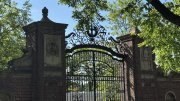Broadly Speaking, the Harvard governance reforms unveiled in December 2010 had three purposes. Foremost was strengthening the Corporation’s fiduciary oversight of the University, in the wake of the 2008-2009 financial meltdown and prior missteps in Harvard leadership. Second, and related, was creating a system (expert committees, term limits and succession plans, a more rational way of selecting the senior fellow) in order to achieve the first goal, while also enabling the governing boards to think strategically about the future. Third was demystifying Harvard’s opaque governance by communicating more about its work.
Having weathered the severest possible stress test—a pandemic that shuttered residential operations—it is time to declare the financial oversight successful. During the 2020 and 2021 fiscal years, despite depressed revenues and strict constraints on endowment distributions (see harvardmag.com/endowment-surplus-21), Harvard operated in the black to the tune of more than a half-billion dollars. After the fiscal 2022 results are reported this autumn, the accumulated surpluses will likely be larger still. Thus, rather than the endowment rescuing University operations, as seemed likely last year when its value soared to $53.2 billion, the operating surpluses yielded by strong financial management may tide the schools over in an environment when endowment investment returns have likely gone into reverse.
So, score one for the reforms.
What about the big-picture stuff? In interviews with this magazine and the Harvard Gazette shortly before his service as the Corporation’s senior fellow concluded June 30 (see harvardmag.com/lee-challenges-22), William F. Lee spelled out what he saw as broader concerns.
The reforms, he told the Gazette, “allow the Corporation to think more strategically—in the short term and long term—about what Harvard needs to do to ensure that it’s still Harvard 50 years from now, and that it is making the contributions to the local, national, and global communities that it should.” Among the items he enumerated in conversation with this magazine were dealing with the cost of education; encouraging interdisciplinary work in fields such as climate change and artificial intelligence; the potential for advances in life sciences, given Greater Boston’s intellectual prowess in this realm; Allston development; the Harvard-MIT relationship; and diversity and demographic change.
Some of these matters seem well in hand: the foothold in artificial intelligence, underwritten by the $500-million commitment to the Kempner Institute; new resources for research and teaching on climate change and sustainability, now anchored by a new vice provost.
On other matters, it would be intriguing to know what the Corporation deliberations amount to. How does Harvard propose to deal with the costs of higher education (or is this code for more online education, particularly of the professional or continuing sort, in which case it is really a revenue matter)? Beyond the cell-manufacturing facility now being fitted out in Watertown, and crisis-driven, collaborative COVID-19 research, how is the life-sciences ecosystem, much bruited-about, evolving to be greater than the individual strengths of separate universities, research institutes, commercial enterprises, and often fractious hospitals? And what is the real potential for the Harvard-MIT relationship? Does Harvard expect to clone its new engineering and applied sciences facilities, in billion-dollar increments, while endlessly racing behind MIT in augmenting its computing faculty? Or has the time come to move beyond one-off collaborations like the Broad Institute (genomics) and nascent work in quantum science?
Finally, to take an issue that is perhaps both best and least understood in the Harvard community at large, what is the Allston strategy? Beginning in the 1980s, when the first properties were assembled, the rationale was to bank land for the next century or more of academic growth. Today, after Harvard has finally opened its first applied-sciences complex (and committed to moving the American Repertory Theater across the river), the enterprise resembles an enormous commercial real estate development, with an initial couple of million square feet of housing, hotel, a Harvard conference center, and office and lab buildings (see harvardmag.com/allston-erc-22 for the latest), with much more to come a decade or two hence. Has the academic ambition faded, or has it morphed in ways not yet perceived beyond Loeb House and Mass Hall? Or is the hope that for-profit development will yield financial returns, much as MIT’s Kendall Square portfolio does, to underwrite the University’s academic operations?
The fact that most Harvard people don’t have a clearer view of what is intended—after decades of work, at least a couple billion dollars of investment, and substantial commitments of Corporation and administration time—suggests an incomplete delivery on the third objective of governance reform: communications. Absent some sense of the Corporation’s strategic decisions (rather than just a broad sense of its interests), its work is unfinished. An effective strategy is widely disseminated, understood, and—in healthy organizations—embraced, so everyone knows which way the future lies, and why.
This is, perhaps, a lot to lay at the feet of Penny Pritzker, the new senior fellow—especially given her leadership of the search for the successor to President Lawrence S. Bacow (read more here). But it is also an opportunity. Defining and articulating Harvard’s objectives—what is Allston for; how should University investment be balanced between facilities and faculty?—might be especially clarifying as the search proceeds, for the Corporation and the candidates alike.
* * *
Readers who pay exceptionally close attention to this magazine may notice atop the table of contents for this issue that this is Volume 125, Number 1. This indeed marks the quasquicentennial year (as the lexicographers like to call it) of Harvard Magazine and its predecessors. We are proud to carry on the tradition of serving you with independent news coverage, in-depth features, and human-interest stories about an important institution and the fascinating alumni, faculty, staff, and students who make it so.
In that spirit, at this landmark anniversary, it is a privilege and pleasure to thank you for your continuing interest and support, and to renew our promise to deliver the best Crimson content possible in the years ahead.
—John S. Rosenberg, Editor









